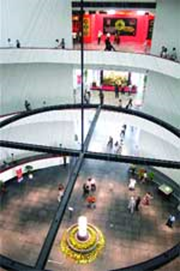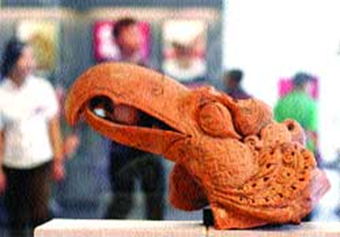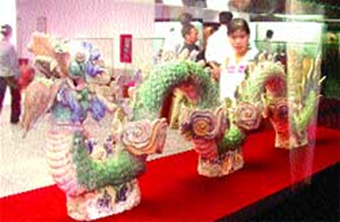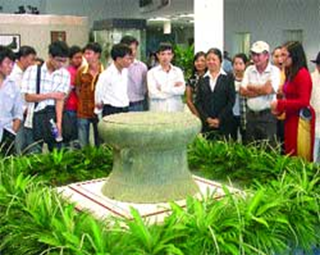The ceremonial opening of the Ha Noi Museum on Wednesday was one of the most anticipated millennium events. Thu Giang & Mai Huong report.
 Today, Thang Long – Ha Noi celebrates its Millennium. Never before have Hanoians and visitors had such a great opportunity to learn about Ha Noi's history as they have during this 10-day celebration.
Today, Thang Long – Ha Noi celebrates its Millennium. Never before have Hanoians and visitors had such a great opportunity to learn about Ha Noi's history as they have during this 10-day celebration.
During the festivities, songs about Ha Noi have been played non-stop on every street corner.
Many exhibitions on diferent aspects of Ha Noi have been organised – the first exhibition of ancient Thang Long Royal Citadel artefacts was held at the citadel site; an exhibition on national heroes and cultural figures was held at the Revolutionary Museum; an exhibition on historic Vietnamese battles was held at the Viet Nam History Museum; along with many others.
One of the most anticipated events, however, was the inauguration of the Ha Noi Museum on Wednesday in Tu Liem District.
As Viet Nam's capital for a thousand years, Ha Noi is considered to be one of Viet Nam's cultural centres, where the legacies of most Vietnamese dynasties still linger. Even though some relics have not survived wars and time, the museum still has many interesting cultural and historic monuments on display.
 Harry Mertodimedjo, an overseas Vietnamese from the Netherlands who returned to Ha Noi for the millennium celebration, says he was born in Ha Noi and is happy that there is now a museum dedicated to his homeland.
Harry Mertodimedjo, an overseas Vietnamese from the Netherlands who returned to Ha Noi for the millennium celebration, says he was born in Ha Noi and is happy that there is now a museum dedicated to his homeland.
Harry says he has learned a lot about the city's history from the museum and is very surprised at the diversity of ancient objects, particularly the numerous bronze and ceramic items. "The museum is large-scale and engaging, with many modern aspects," he says.
"For a long time, Hanoians have wished to have their own dedicated museum, and now that dream is a reality," said National Assembly Chairman Nguyen Phu Trong at the museum's ribbon-cutting ceremony.
The museum has about 50,000 objects on display, all selected to provide the public with a deeper understanding of the capital's history.
Trong says Ha Noi is not only the country's political and economic centre, but also its largest centre of culture and education, where civilisation has solidified and shined for thousands of years.
"With more than 50,000 objects accumulated from various historical eras, it would be a sin to our ancestors not to preserve, exhibit and maintain them for our descendants," he says.
Pham Quang Nghi, Ha Noi Party Committee Secretary, agrees. "It is essential for Ha Noi to have a museum which merits its status and significance."
 Nghi says the museum represents an exemplary cultural work and is a new landmark for the capital.
Nghi says the museum represents an exemplary cultural work and is a new landmark for the capital.
The old Ha Noi Museum, established in 1982, was situated in a small, old house on Ham Long Street that was not large enough to present all of its grand treasures.
The new museum is the largest of its kind in Viet Nam, comprised of four stories and a two-story basement covering a total area of 54,000 square meters. Work began on the VND2.3 trillion (US$121 million) project in May 2008.
The museum was designed as an upside-down pyramid, with the fourth floor as the largest, symbolising eternity and immortality. It also evokes the image of a lotus blossom.
A letter inscribed in bronze to future generations of Ha Noi is the centrepiece of the museum's Grand Hall.
The one-thousand-word letter was written on a 65x105cm bronze picture carved with two Ly Dynasty dragons. The design is reminiscent of the legendary dragon that ascended the Red River when King Ly Cong Uan moved the capital of Dai Viet from Hoa Lu to Dai La Citadel in 1010, and renamed it Thang Long (Ascending Dragon).
 An image of the Khue Van Cac (Temple of Literature) – a symbol of Vietnamese traditional education – is inscribed in the centre of the letter.
An image of the Khue Van Cac (Temple of Literature) – a symbol of Vietnamese traditional education – is inscribed in the centre of the letter.
"The letter connects the past, present and future. It includes information Hanoians wish to pass on to the next generation of Hanoians 100 years from now," said Ha Noi Party Committee Secretary Pham Quang Nghi.
By following the exhibits, visitors will learn about the 1,000 year history of the capital city, from its dawn to the present.
Archaeologists have traced Ha Noi's history back 2,000 years to the Dong Son culture – a glorious era that marked what is believed to be the first development in Ha Noi when Co Loa – one of the world's first cities – was chosen as the capital by King An Duong.
A large collection of terracotta home utensils and bronze drums are on display to open a window onto this splendid era.
Materials and artefacts from prior to the Thang Long era describe the state-making process, which saw the people engage in many fights against foreign invaders to seek independence which led to the establishment of the Dai Viet (Great Viet) state and the construction of Thang Long capital in the 11th century.
Folk paintings of national heroes such as Hai Ba Trung and Ngo Quyen in battles against invaders represent their spirit for national independence.
Another display of Vietnamese ceramics created during the Ly, Tran, Le and Nguyen dynasties, which together span 1,000 years, exposes the cultural development history and spiritual lives of the ancient people.
 The museum also offers spacious areas for exhibitions by individual collectors.
The museum also offers spacious areas for exhibitions by individual collectors.
Nguyen Dinh Su's exceptional collection of hundreds of different forms of Vietnamese currency, made of bronze coins and paper, is one example. The currency was produced during many of Viet Nam's dynasties.
An extraordinary exhibition on Vietnamese and European antiques and Bat Trang pottery from the 16-19th century owned by Vu Tan is also on exhibit.
Visitors have expressed their astonishment at the sophistication and variety of Tan's collection of terracotta vases which include depictions of dragons and bodhi leaves on ridge tile. The collection also includes old European artefacts including a candle holder, a statue of Jesus Christ, a holy bread container, lamps and clocks which were used in European-styled houses in Ha Noi.
"I show European home utensils, particularly French, because they are part of Ha Noi's past. Such European interior decorations are unique and were skilfully made by hand," says Tan.
The museum is not meant to be a warehouse for historical materials and artefacts. All of the objects need to somehow connect to each other to create a thread linking the past to the present.
With this in mind, Ha Noi is beautifully and comprehensively demonstrated through familiar and charming figures which have long been symbols of the capital.
Symbols include Sword Lake's turtle, hoa sua (milk flowers), sam cam (black coot bird), and Ha Noi's traditional cuisine including West Lake shrimp cakes and La Vong grilled fish.
Songs about Ha Noi are also played around the museum to further sharpen visitors' feelings for the capital.
Listening to a song about hoa sua – a symbol of Ha Noi's beauty – evoke images of branches covered with small white flowers knitted together and their beautiful scent as it fills the air.
Old pictures of Ha Noi – Ha Noi women wearing traditional dresses, the flower market during the Tet holiday, the Old Quarter under the French rule – provide visitors with a deeper look at the elegant lifestyle of Hanoians in past years.
Hoang Trung Tinh, 52, from Vinh Phuc Province who is in town for the anniversary celebrations, says: "I am very touched by looking at so many beautiful objects."
As a man who grew up during war time, Tinh says he has a basic knowledge of history, but as he looks at the genuine artefacts in such a large, modern museum, he is even prouder of Ha Noi and Viet Nam's history.
"I shall organise another tour for my family to visit Ha Noi and the museum sometime in the next two months," he says.
Tran Quang Hai, 23, a student, says the Ha Noi Museum is the largest and most modern he has ever visited, with exceptional architecture and a variety of showpieces.
"Today, I have learned more about Ha Noi. This is a very attractive destination and I will come back with my friends," Hai says.
Ha Noi Museum is a source of pride for all Hanoians as it is opened in time for the city's Millennium. The museum is not only the bridge from the past to the present, but also the heart to the city for all Hanoians – a city which has overcome many upheavals throughout its history to become the country's centre of politics, economy and culture and the place for solidifying the nation's quintessence and gathering talented people.
Source: Viet Nam News [October 11, 2010]